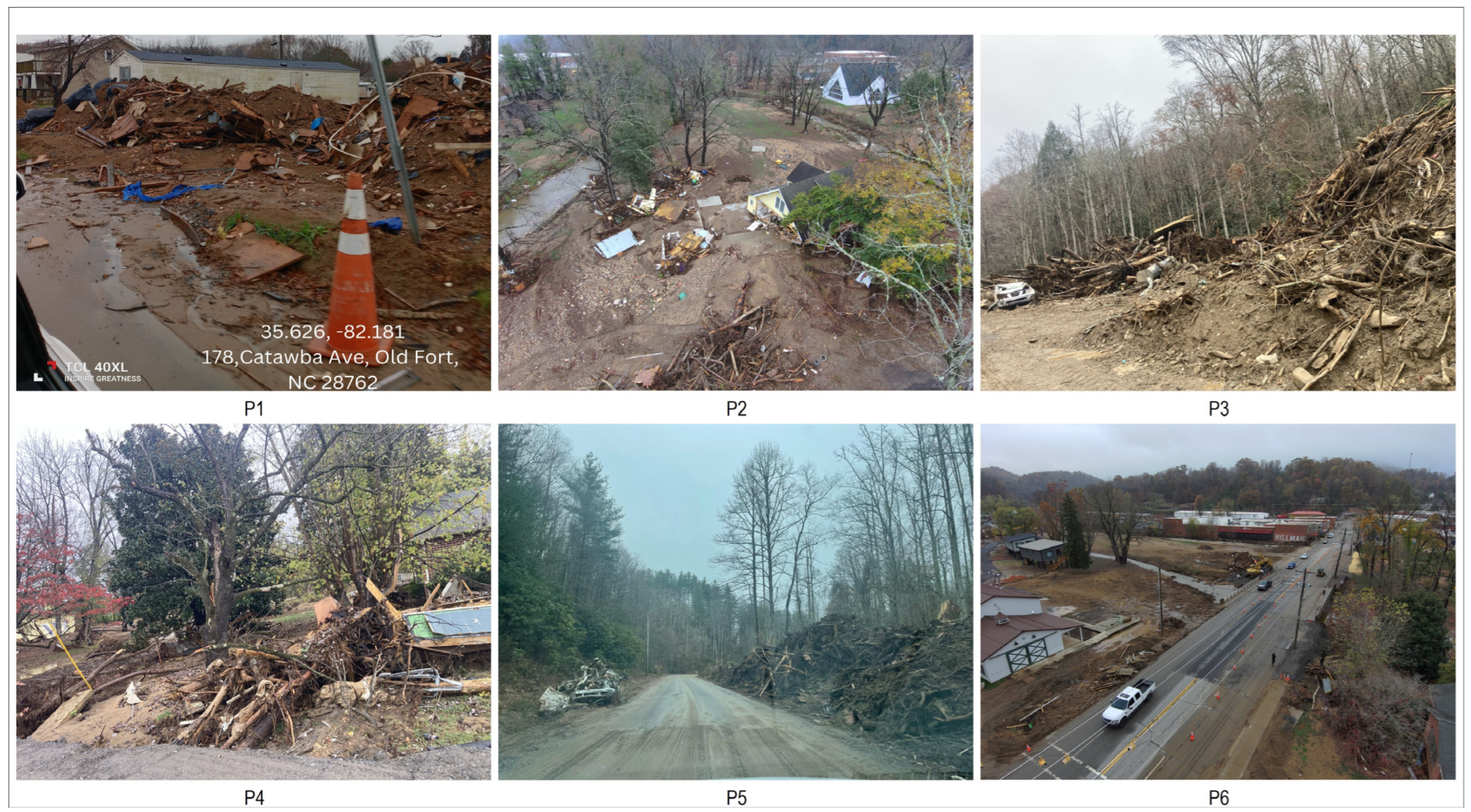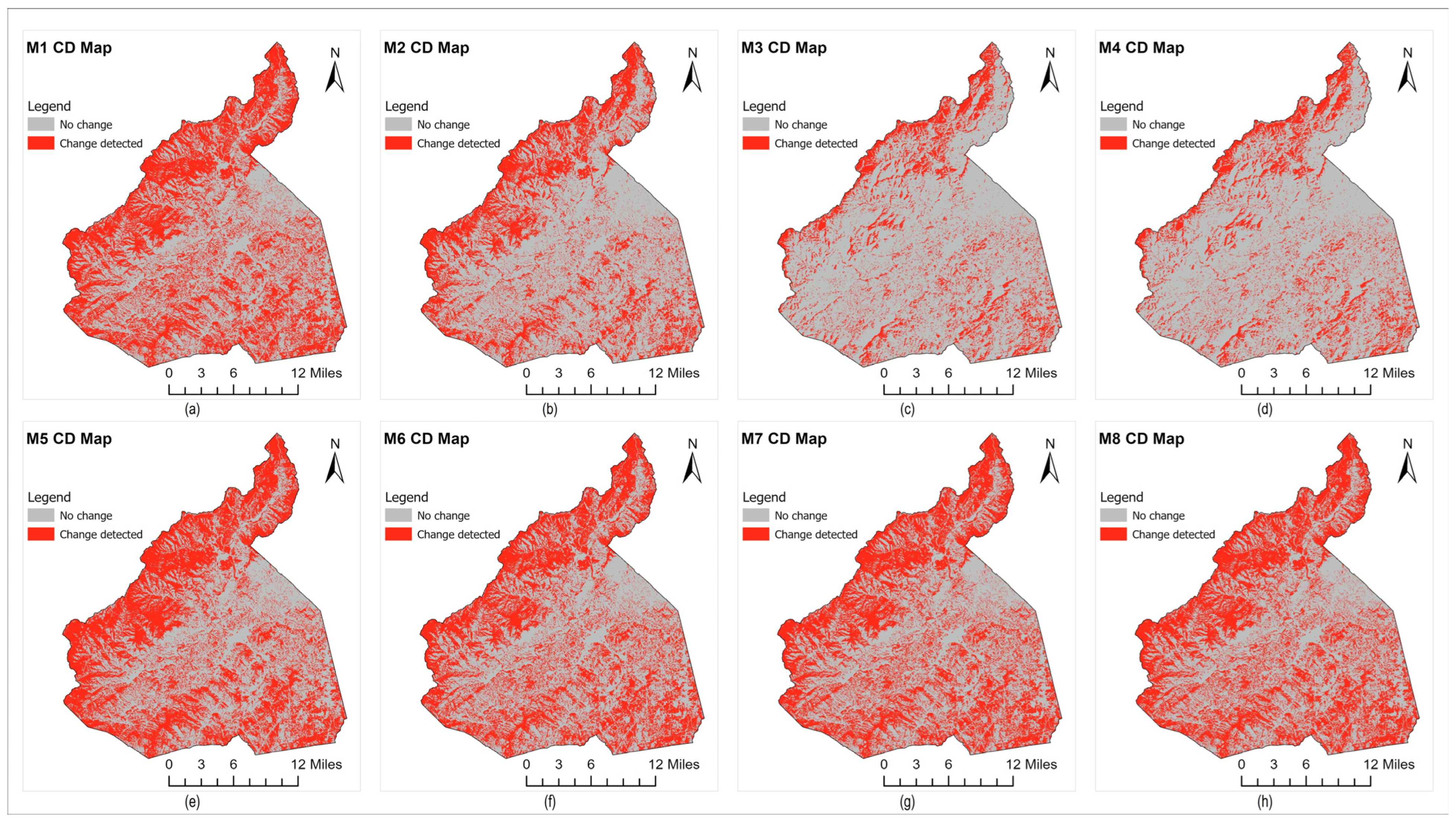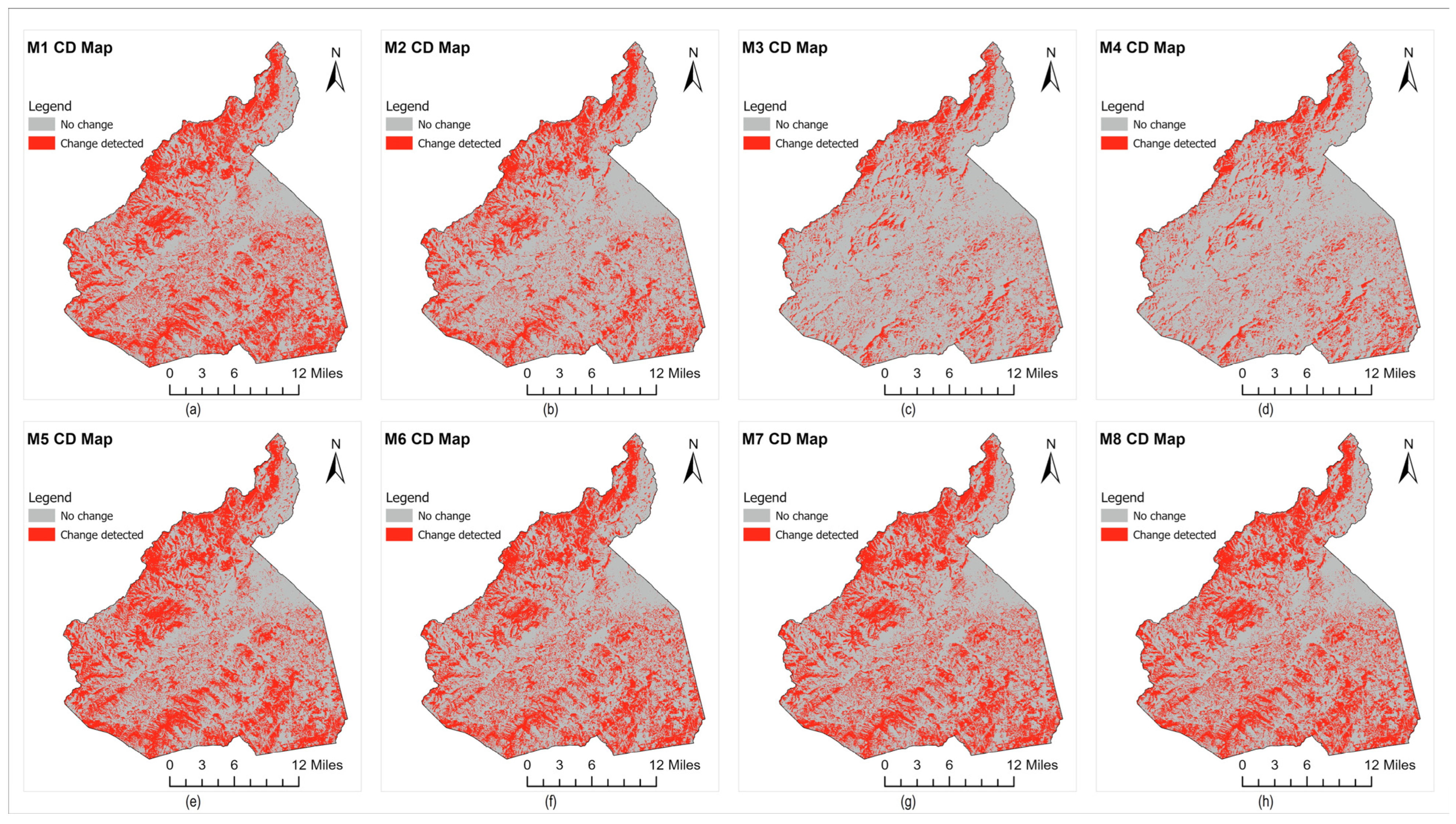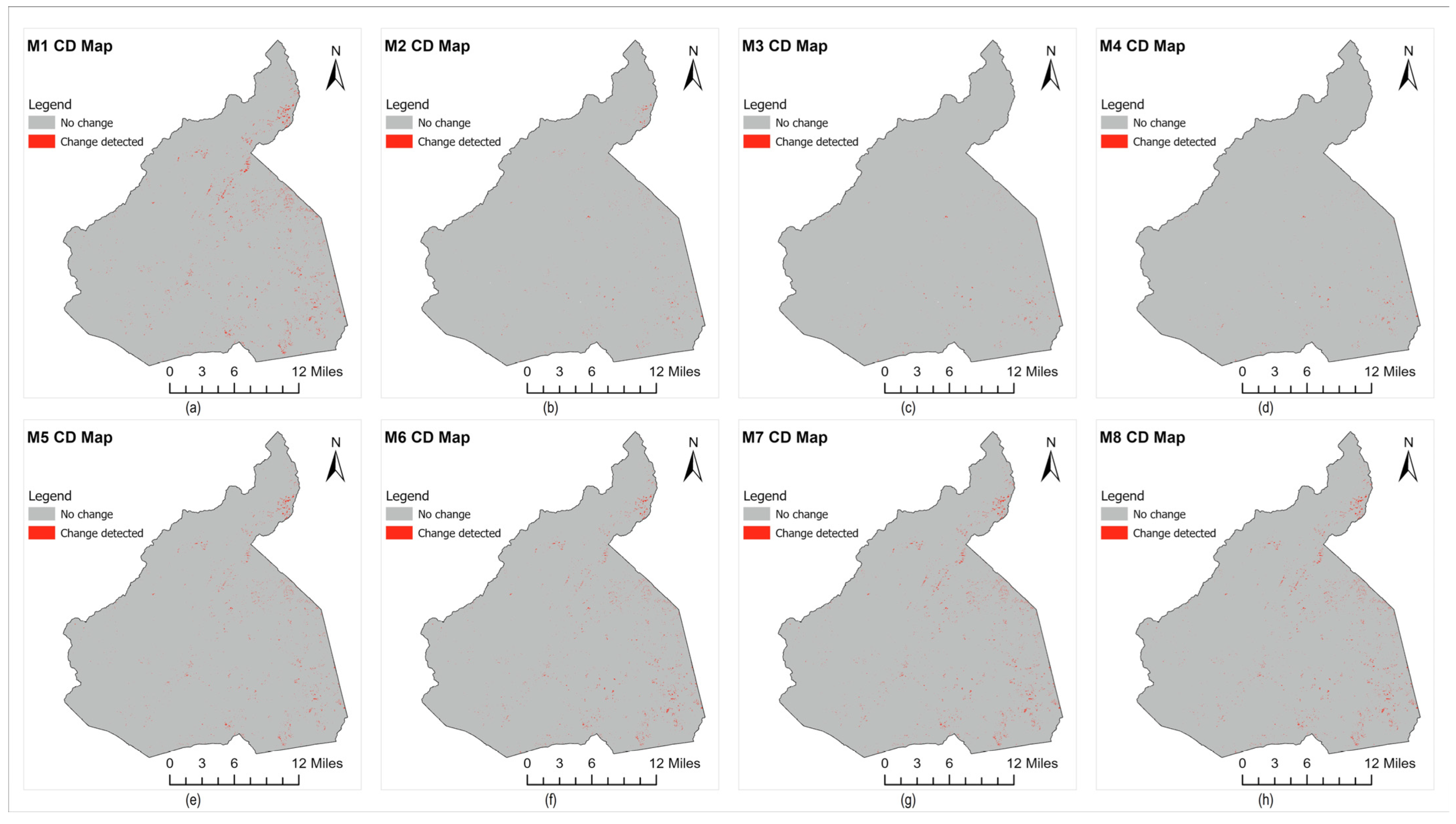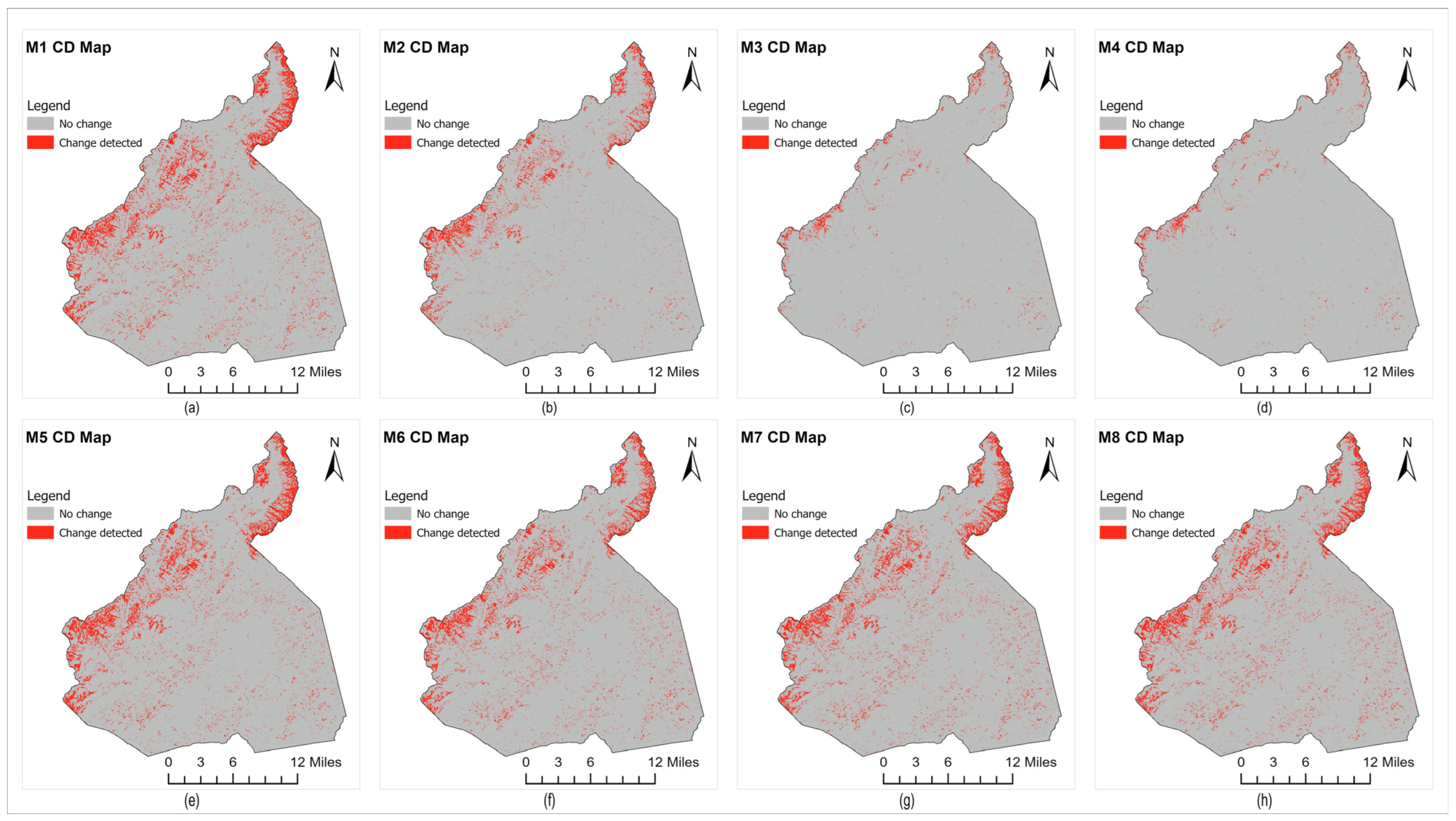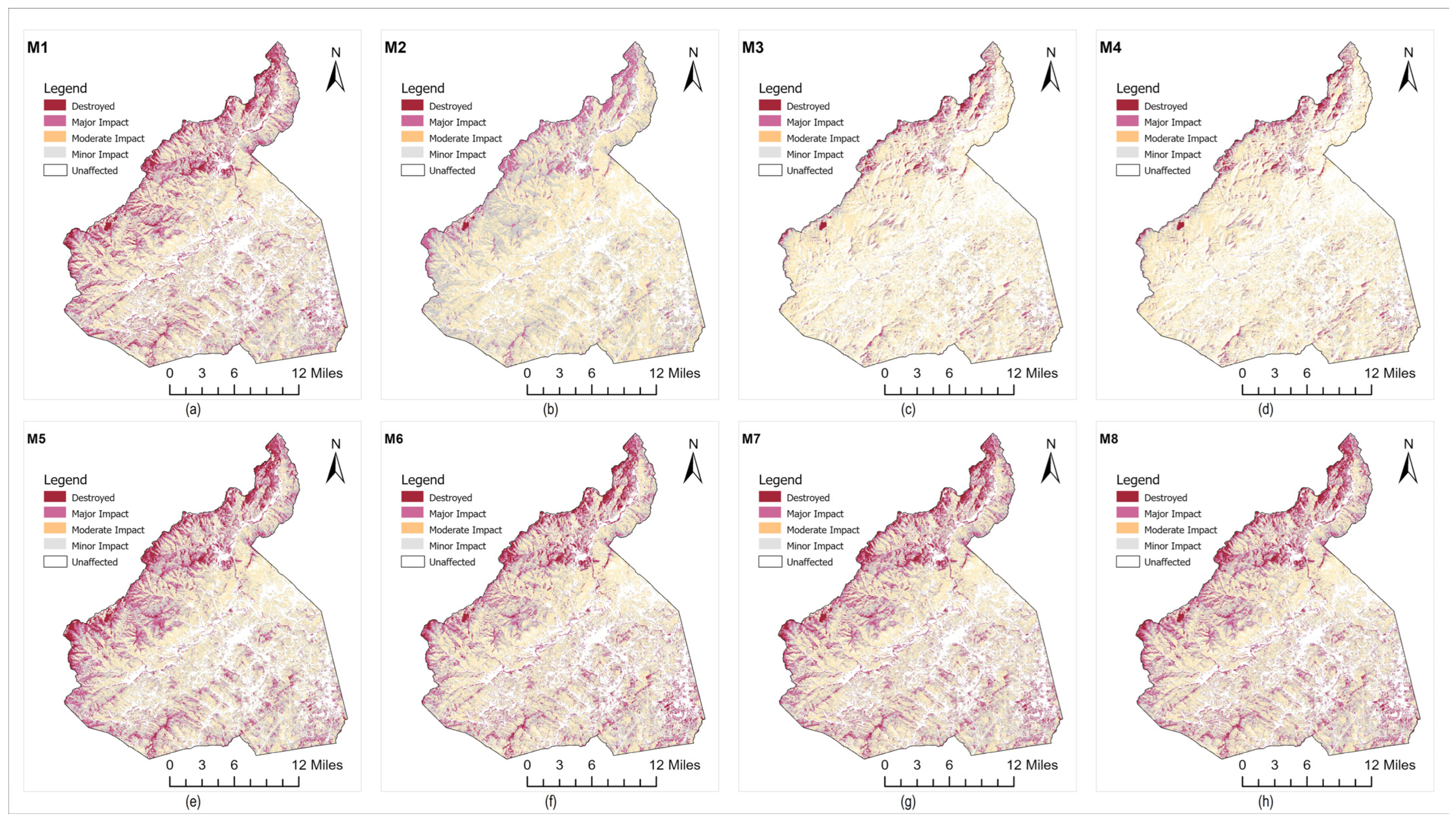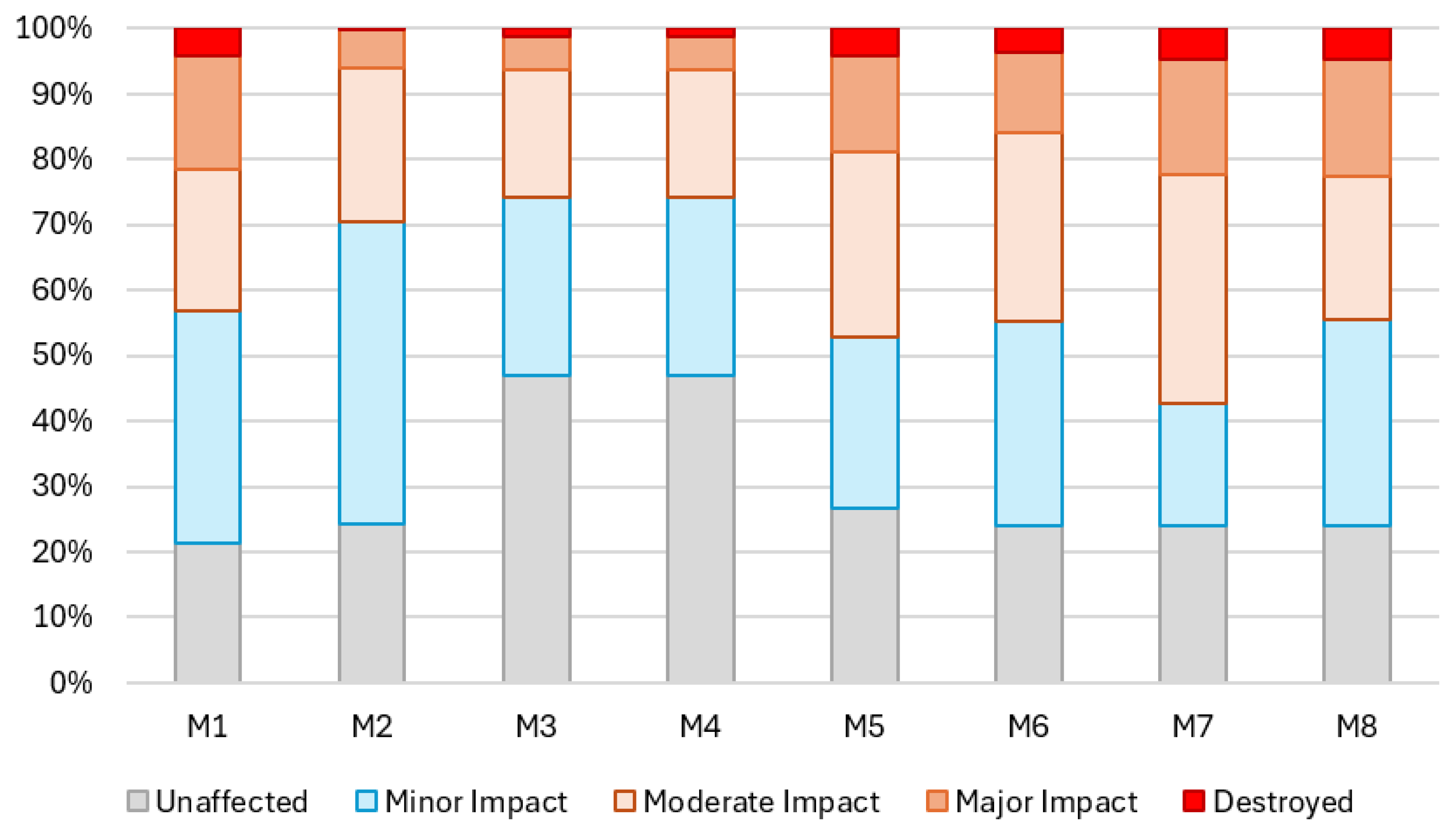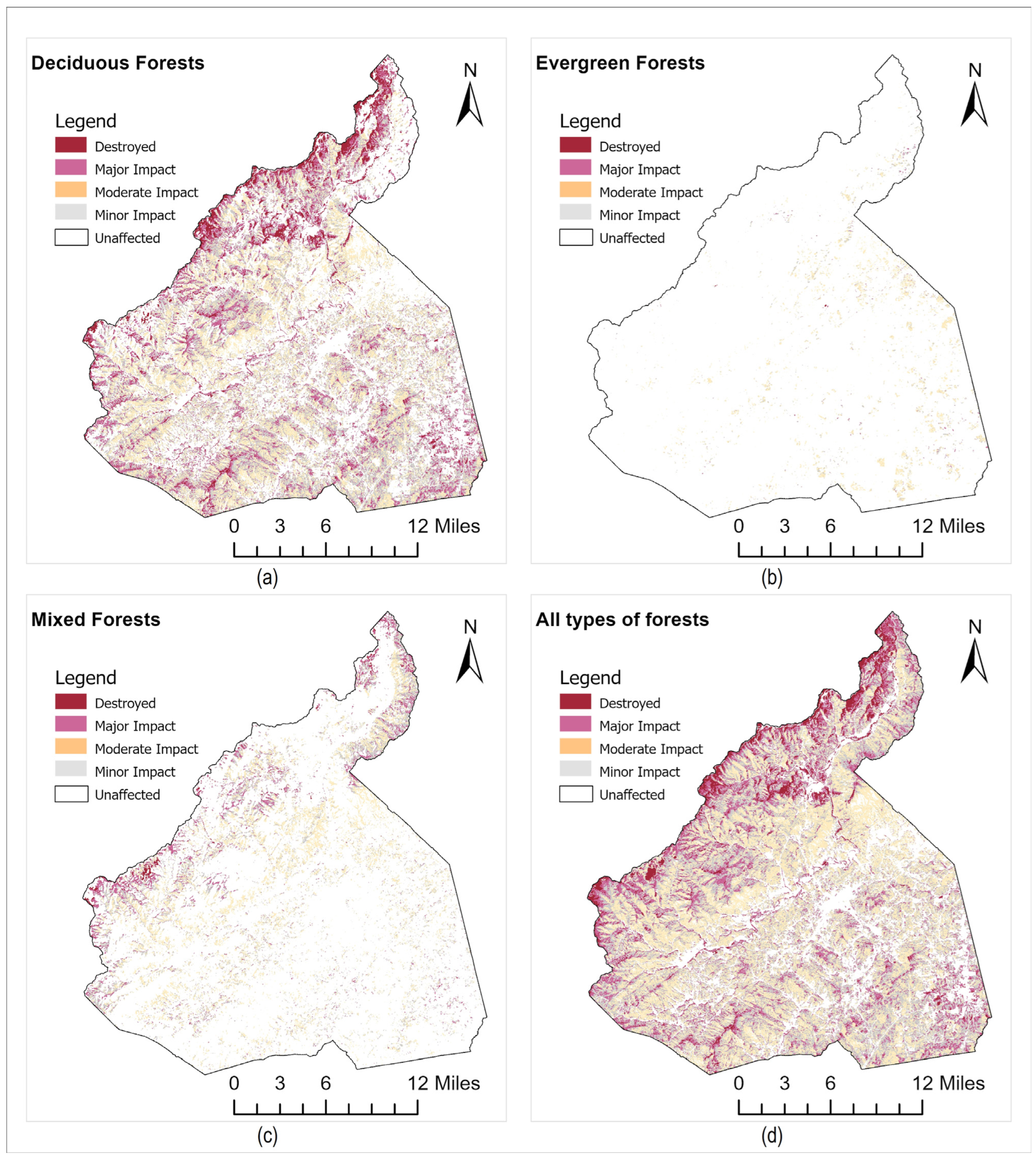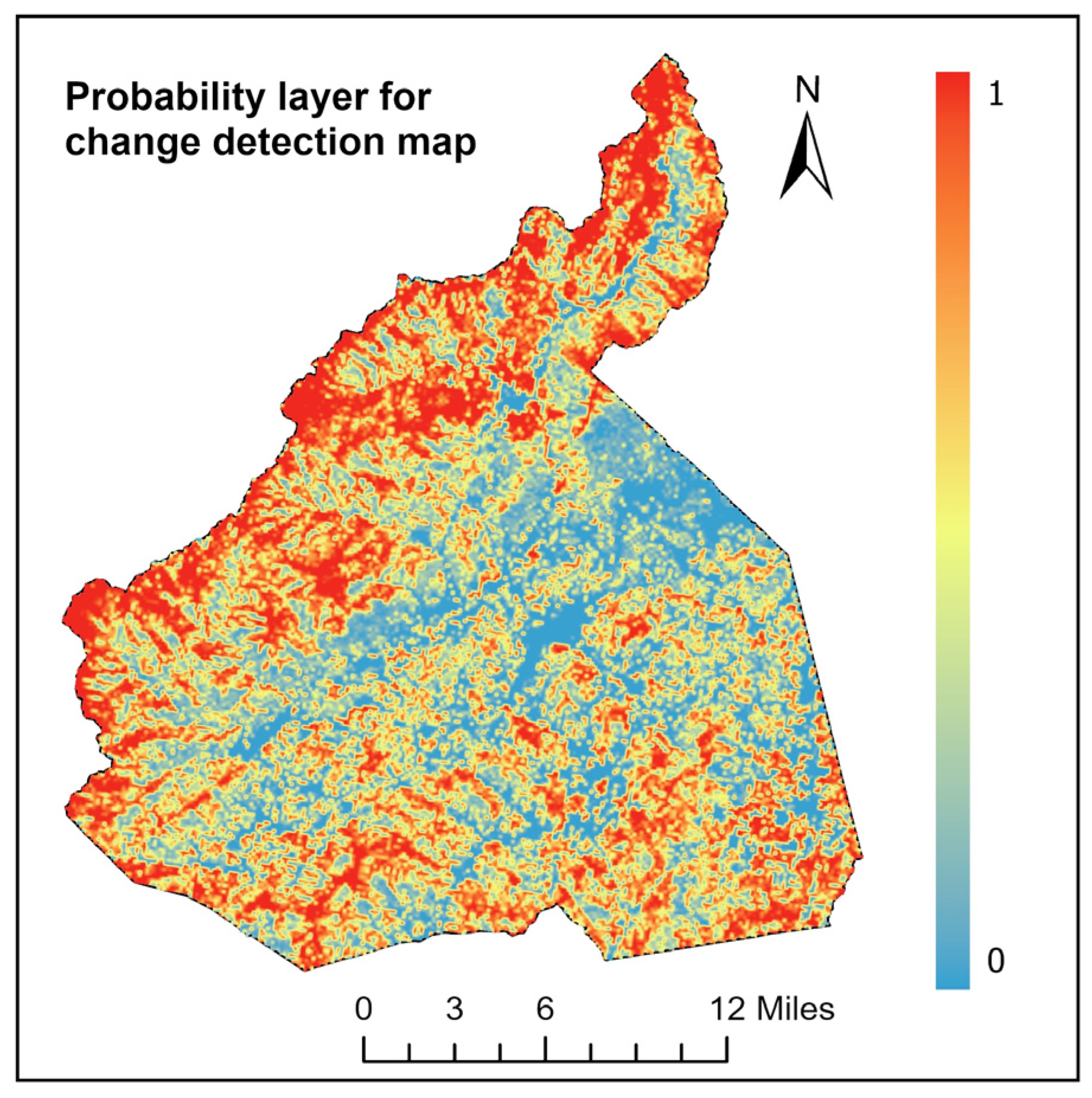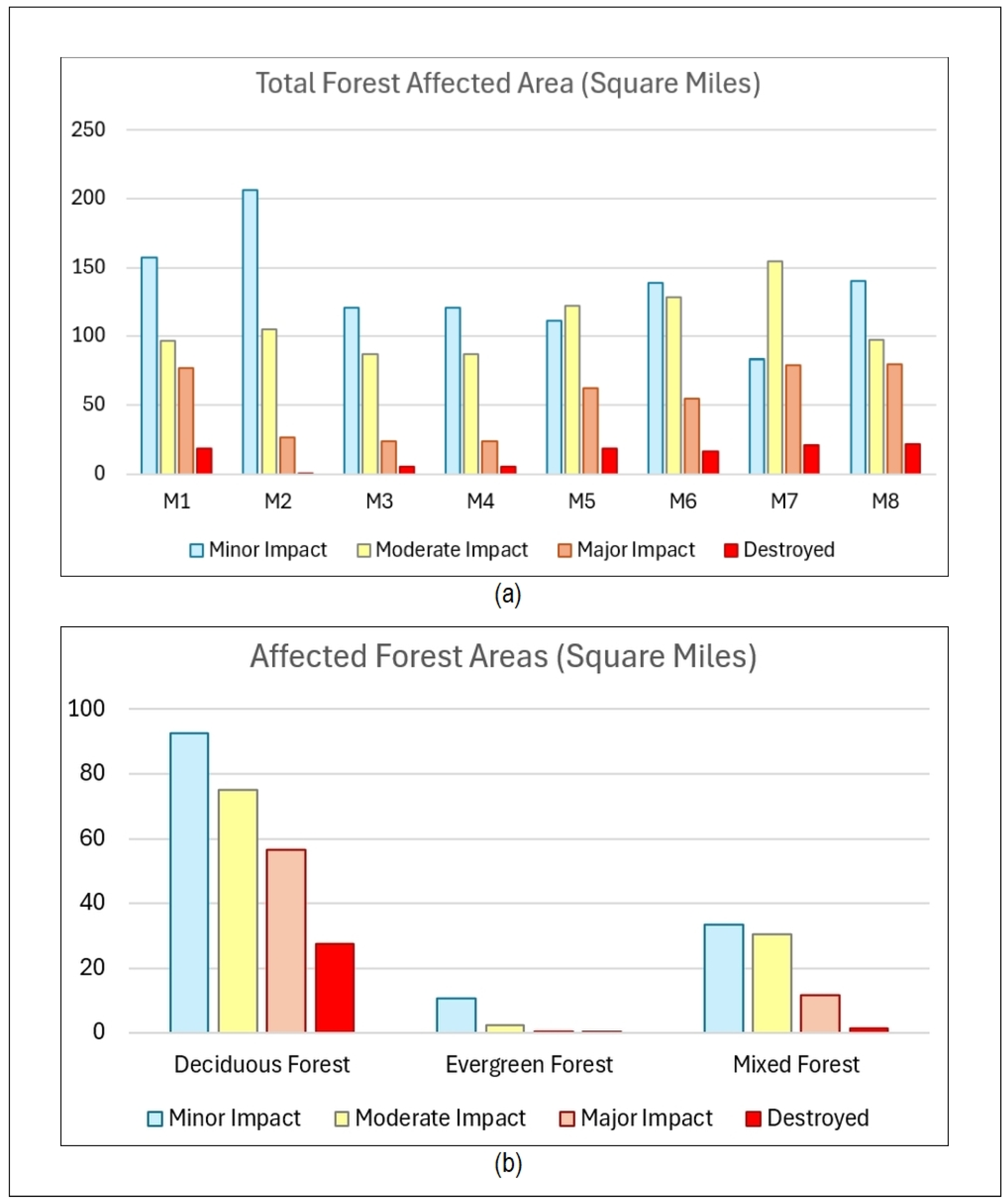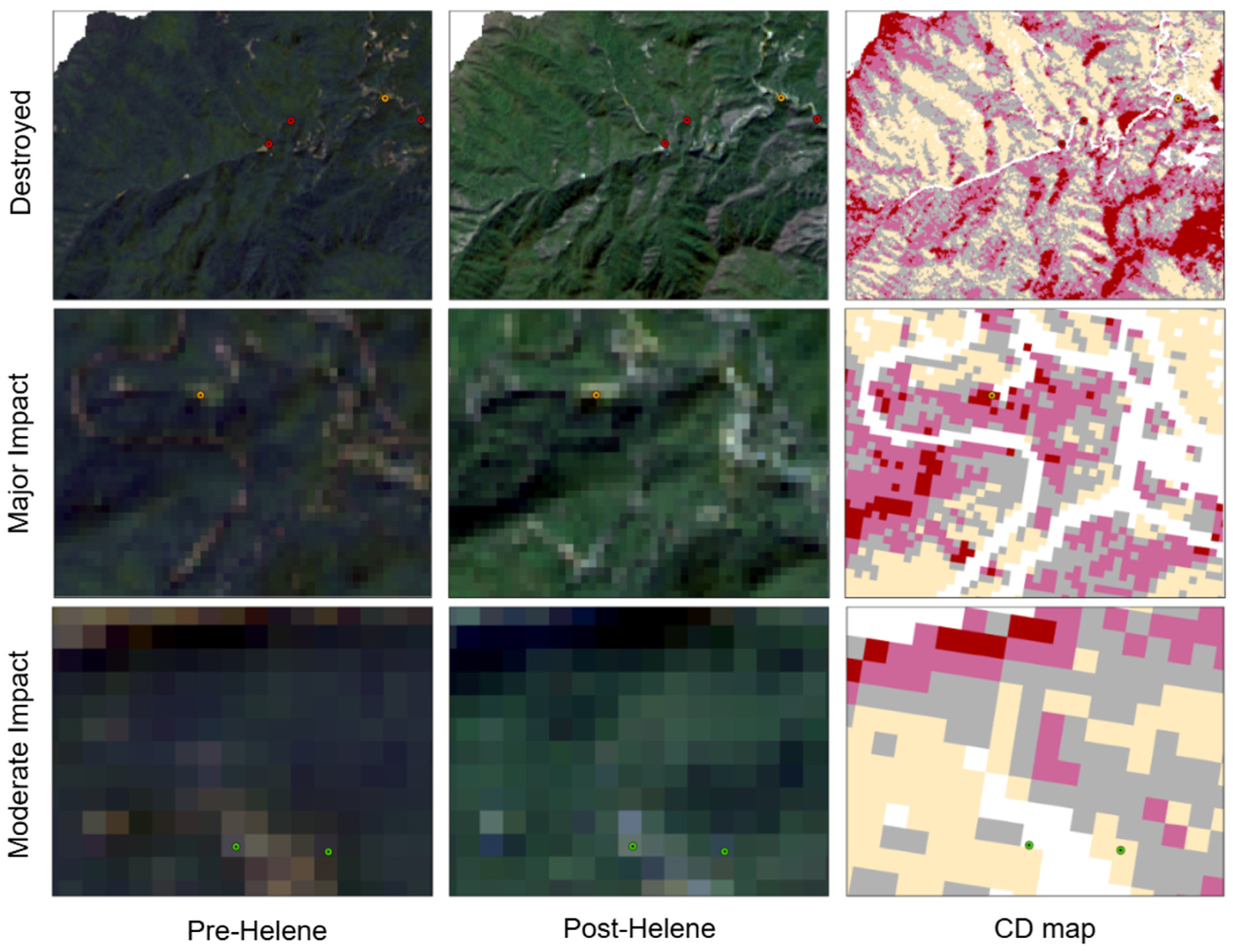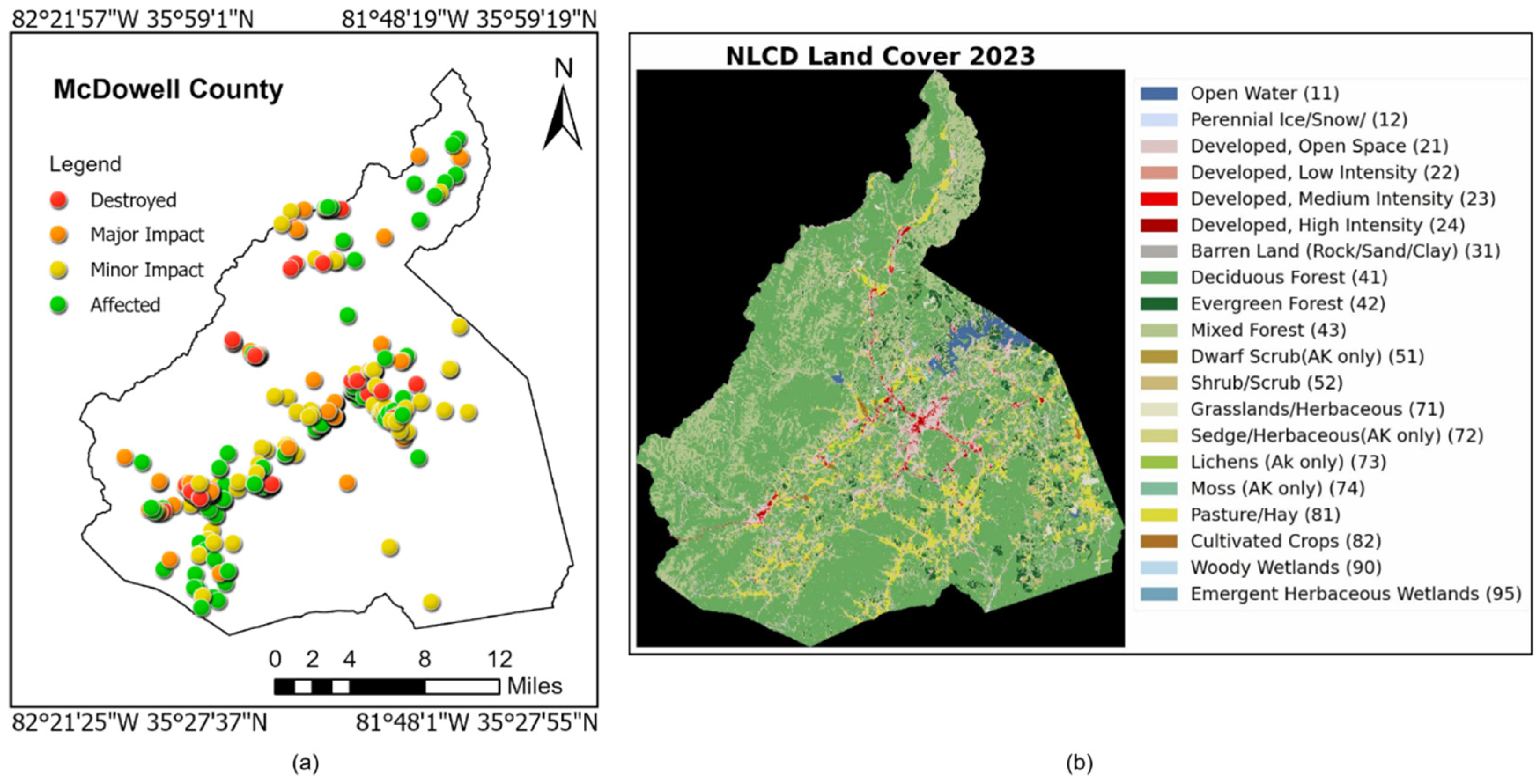1. Introduction
Hurricanes constitute a significant natural disruption to forest ecosystems in the southeastern United States. A powerful hurricane may significantly impact the composition, structure, and succession of forests [
1,
2]. The increasing number of forest disturbances and their severity in the recent past necessitates prompt and precise local forest damage assessments to facilitate post-hurricane forest management after the hurricane, hazardous fuel control and mitigation, relief activities, and administrative compensation requests [
3,
4]. Western North Carolina has traditionally suffered considerable flooding and destruction from weakening hurricanes or their leftovers, despite being situated well inland from coastal areas that usually experience the most severe and widely reported effects. This results from heavy rainfall that can lead to the considerable swelling of rivers and water bodies, along with torrents cascading down hilly regions, resulting in destruction and damage [
5]. Hurricane Helene made landfall on Florida’s Gulf Coast on 26 September 2024, as a powerful category 4 hurricane, including maximum sustained winds of 140 miles per hour. Helene arrived in North Carolina on 27 September 2024, by which time the western section of the state had already experienced significant rainfall. Helene produced far greater precipitation, resulting in three-day rainfall totals of over 8 inches in North Carolina’s mountainous region and over 12 inches in some locations. The highest local rainfall maxima in the state surpassed 30 inches for only the second occasion in reported history [
6].
A precise assessment of the extent and intensity of areas affected by the hurricane, along with the identification of factors influencing the spatial distribution of the disturbance, is crucial for local and national governments to facilitate post-hurricane relief efforts, inform decision-making, and enhance risk management. Traditional methods for evaluating damage and quantifying losses rely on site visits to gather information via questionnaires, interviews, and photographs for preliminary assessment [
7,
8,
9,
10]. Nevertheless, acquiring comprehensive information necessitates significant time (days or weeks) contingent upon the accessibility and extent of the harm in the impacted region. Therefore, the development of enhanced, efficient approaches for quantifying damage losses in less time and with minimal labor is of particular significance.
Many existing studies have relied on satellite remote sensing, utilizing changes in various vegetation indices as indicators of affected forest areas, with limited attempts to assess their quantitative correlation with forest damage at the pixel level and few comparative analyses regarding their efficacy [
11,
12,
13,
14,
15]. Landsat datasets were utilized for quantitative damage assessment of vegetation dynamics [
11] and cyclone damage to dry forests [
15]. Change detection in remote sensing entails utilizing two or more aerial or satellite images of the same geographic region to identify changes in land use and land cover characteristics during a period. Change detection processes typically encompass the preprocessing of satellite imagery, feature extraction, the application of change detection methodologies, and the evaluation of accuracy. Image preprocessing typically involves a sequence of operations, including the reduction in atmospheric effects on radiance, precise image registration, the extraction of areas of interest, and the conversion of images to indices that exhibit a robust correlation between their values and land cover attributes. The majority of change detection methodologies employ per-pixel classifiers, such as the post-classification comparison technique, and rely on pixel-based change information derived from the spectral domain of the images [
16,
17]. Change detection methods, like univariate image differencing (UID), are needed to spot changes by looking at the pixel-level information in images. UID is a method in which the pixel values of the spectral index or remote sensing imagery from one date are subtracted from another date [
17]. The disparity in areas with no change will be minimal, whereas places of change will have substantial positive or negative values.
Spectral indices are derived from basic band arithmetic procedures, utilizing the distinct reflectance patterns of land cover and land use objects across various energy spectra [
18,
19,
20,
21]. The prior methodologies can be categorized into numerous groups according to the spectral indices derived from the separate physical principles employed in forest canopy detection: (1) detection utilizing changes in chlorophyll concentration [
22,
23,
24], (2) detection employing variations in the presence of water content in leaves [
25,
26,
27,
28,
29], and (3) detection based on spectral mixture signatures [
30,
31,
32,
33,
34,
35]. The authors in [
30] described the application of spectral mixture analysis, which illustrated a viable method for retrieving different types of vegetation. Their methodology depended on endmember classification utilizing high-resolution images. Nevertheless, limited research has documented the quantitative evaluation of forest damage following hurricanes.
This study extends past remote sensing research by integrating spectral indices with GIS data to provide a more detailed and accurate assessment of post-hurricane forest damage across different forest types—deciduous, evergreen, and mixed. This research identifies a composite spectral mixture model tailored to specific forest classifications, enhancing damage detection precision. Furthermore, the study introduces a validated methodology for post-hurricane damage assessment, supported by independent field surveys and GIS datasets, which strengthens the reliability and applicability of the findings in real-world disaster response and forest management scenarios.
This paper aims to investigate the efficacy of widely utilized spectral indices in detecting post-hurricane damage and to integrate GIS data for evaluating damage severity in hurricane-affected areas. The explicit objectives of this study are to (1) identify a reliable composite spectral mixture model for detecting affected areas and assessing damage severity in deciduous, evergreen, and mixed forest types, (2) implement and analyze a methodology for post-hurricane assessment, and (3) validate this methodology using independent field surveys and GIS data.
4. Discussion
To visually compare the sensitivity of different indices in the proposed mixture models for detecting forest damage, pre- and post-Helene histograms of NDVI, NDWI, SAVI, and TCW are presented in
Figure 16. As models M1, M7, and M8 are found to be better-performing models in terms of precision, F1 score, OA, and JS, we investigate their constituent spectral indices NDVI, NDWI, and SAVI for statistical comparison. Consistent with the work in [
47], we observed from the results of the multiple spectral signatures that using more than one spectral index can be quite advantageous for forest disturbance detection. The authors in [
47] examined the utility of multiple spectral indices and corresponding correlations to detect improved forest disturbances in an ensemble setting. These results further align with the findings in [
48]. Spectral indices based on three conceptually independent categories corresponding to soil, vegetation, and moisture characteristics improved the accuracy of forest change detection [
48]. To enhance the study, the histograms employ lines rather than traditional bar charts to depict the distribution of ∆SIs. The amplitude of the change was directly correlated with the sensitivity of these indices to hurricane impacts. The authors in [
49] utilized NDVI, TCG, and TCB to evaluate change detection using remote sensing images for land cover applications for improved performance. The larger shift in ∆NDVI (0.11) as compared to ∆SAVI (0.09), ∆TCG (0.05), and ∆TCW (0.08) contributed to improved accuracy (
Table 7). This result is in agreement with the work presented in [
49]. The NDVI–albedo combination was found to be better than the TCG–TCB-based combinations [
49]. This result also aligns with the outcome presented in [
50] to assess the desertification risk using change vector analysis.
The shift amplitude of ∆NDWI (0.14) exceeded that of ∆TCW, ∆NDVI, and ∆SAVI, as illustrated in
Figure 16 and
Table 7. The large shift amplitude of ∆NDWI means the number of pixels with decreased NDWI after the hurricane increased significantly, as found in models M7 and M8. The shift amplitude of ∆NDVI (0.11) was a bit greater than that of ∆SAVI and ∆RVI (0.09), although it remained of lesser importance in comparison to the shift amplitude of ∆NDWI. This aligns with the findings in [
51], which exploited NDWI signatures to detect changed pixels with improved detection rates. TCG distributions before and after Helene showed no discernible changes, suggesting that the index is not affected by the hurricane’s effects on the canopy’s greenness and the forest structures. This distinct exhibition of spectral characteristics also facilitated similar change detection, as reported in [
52].
The interquartile range (IQR) as a measure of statistical dispersion reflects the ability of an indicator to differentiate between levels of forest damage severity. An indicator with significant dispersion can more effectively distinguish levels of damage severity compared to other indications. The proportion of damaged forest pixels detectable by an indicator reflects the indicator’s overall capability in identifying impacted areas. The statistical dispersion of ∆SIs (
Table 7) demonstrated the index’s sensitivity to varying levels of damage severity. The substantial interquartile range of ∆NDWI (0.319) indicated that the higher ∆NDWI values in the left tail exceeded those of ∆NDVI and ∆SAVI.
To clearly show how well our proposed method works, we present samples with different levels of damage and validation points from GIS data in
Figure 17. The pixels showing destroyed areas, as well as those with major and minor damage, are found and examined in comparison to the sample tiles before and after Helene, along with the changes in the change detection map and the GIS data points. The change map results align with the GIS data points as indicated by the red, orange, and green points in
Figure 17. The impacted areas indicated by the proposed mixture model of composite indices turned out to be more consistent with different damage severity.
The forest damage leads to the loss of critical ecological structures with varying impacts across forest types. In predominantly deciduous stands—dominated by oaks, maples, and hickories—hurricanes often cause widespread crown damage and stem breakage. Mature canopy trees, particularly oaks, are highly susceptible due to their height and extensive crown area [
53]. However, mid-story and shade-tolerant species like Acer rubrum often survive and proliferate in the increased light environment, altering post-disturbance composition [
54]. Over the long term, the loss of dominant canopy species may reduce carbon storage and biodiversity, though natural regeneration processes support eventual recovery. Evergreen forests, especially those containing eastern white pine and hemlock, are vulnerable to windthrow and snap during severe hurricanes. Recovery in these forests is often slower due to limited resprouting ability and lower species diversity [
55]. Mixed forests, common at mid-elevations, tend to exhibit more complex and variable responses. Their diversity can enhance resilience, but recovery depends on the balance of shade-tolerant and pioneer species [
56]. Following hurricane disturbance, studies in the Southern Appalachians have documented increased dominance of red maple and birch species, sometimes at the expense of oaks and other late-successional trees [
57]. Understanding these dynamics is crucial for forest management and conservation strategies. Monitoring recovery trajectories through high-resolution time series analysis can assist in distinguishing areas of potential recovery from those requiring active intervention.
Among the models tested, M8, M7, and M1 demonstrate the highest sensitivity in detecting severe forest damage, with M8 consistently outperforming the others across both the “destroyed” and “major impact” categories. A key novel contribution of this study is the use of composite index combinations, particularly in M8, which leverages synergistic information from spectral indices. This composite approach enhances the model’s capacity to distinguish between varying levels of forest damage, enabling more nuanced assessments compared to other models. The integration of indices such as NDVI, NDWI, and SAVI contributes to the superior performance of M8, highlighting the value of combining spectral features in post-hurricane forest damage detection. The findings, while derived from a specific case study, have potential for generalization to other hurricane-impacted forest ecosystems, especially those with similar vegetation types and canopy structures. However, local calibration may be necessary to account for variations in forest composition, topography, and hurricane intensity. To ensure timely application during future hurricane events, this workflow can be updated and reproduced rapidly using satellite images and pre-configured processing scripts. A set of updated composite indices can be generated within days of image availability, allowing rapid post-disaster assessments. The success of composite models suggests that this methodology could be adapted and applied to other regions prone to hurricane disturbances. Factors such as index sensitivity to subtle vegetation changes, cloud cover interference, and limitations due to satellite pixel resolution can introduce variability in detection accuracy. For example, cloud-obscured scenes may lead to incomplete or misclassified damage zones, while coarse spatial resolution may obscure small-scale disturbances. Future work could incorporate time series analysis using high-resolution images and uncertainty quantification methods, such as confidence intervals or ensemble modeling, to better represent these limitations and improve the robustness of damage assessments.


